recommended oil CHEVROLET KODIAK 2007 Owners Manual
[x] Cancel search | Manufacturer: CHEVROLET, Model Year: 2007, Model line: KODIAK, Model: CHEVROLET KODIAK 2007Pages: 430, PDF Size: 6.06 MB
Page 102 of 430
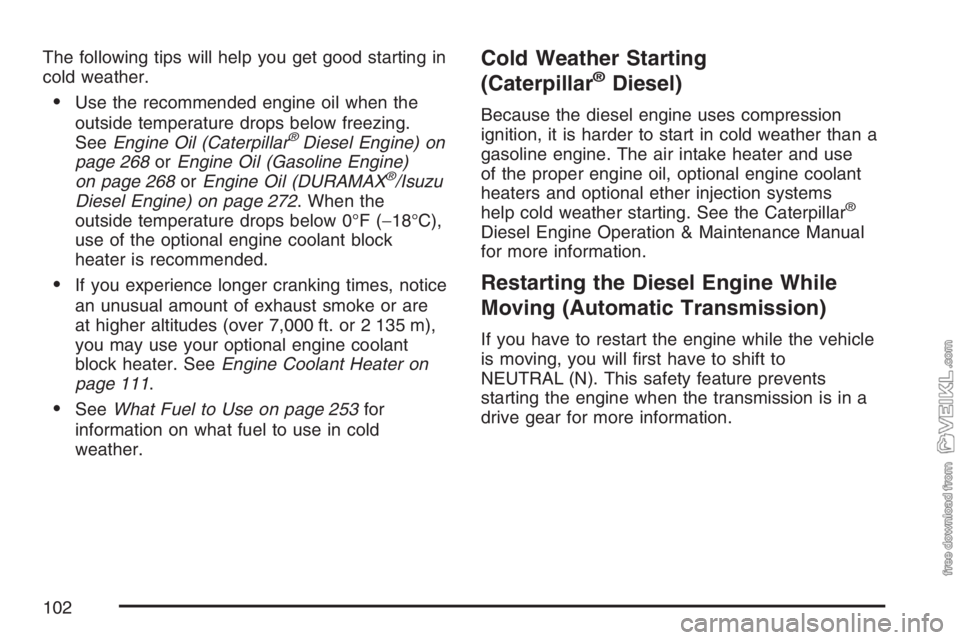
The following tips will help you get good starting in
cold weather.
•Use the recommended engine oil when the
outside temperature drops below freezing.
SeeEngine Oil (Caterpillar
®Diesel Engine) on
page 268orEngine Oil (Gasoline Engine)
on page 268orEngine Oil (DURAMAX
®/Isuzu
Diesel Engine) on page 272. When the
outside temperature drops below 0°F (−18°C),
use of the optional engine coolant block
heater is recommended.
•If you experience longer cranking times, notice
an unusual amount of exhaust smoke or are
at higher altitudes (over 7,000 ft. or 2 135 m),
you may use your optional engine coolant
block heater. SeeEngine Coolant Heater on
page 111.
•SeeWhat Fuel to Use on page 253for
information on what fuel to use in cold
weather.
Cold Weather Starting
(Caterpillar®Diesel)
Because the diesel engine uses compression
ignition, it is harder to start in cold weather than a
gasoline engine. The air intake heater and use
of the proper engine oil, optional engine coolant
heaters and optional ether injection systems
help cold weather starting. See the Caterpillar
®
Diesel Engine Operation & Maintenance Manual
for more information.
Restarting the Diesel Engine While
Moving (Automatic Transmission)
If you have to restart the engine while the vehicle
is moving, you will first have to shift to
NEUTRAL (N). This safety feature prevents
starting the engine when the transmission is in a
drive gear for more information.
102
Page 203 of 430
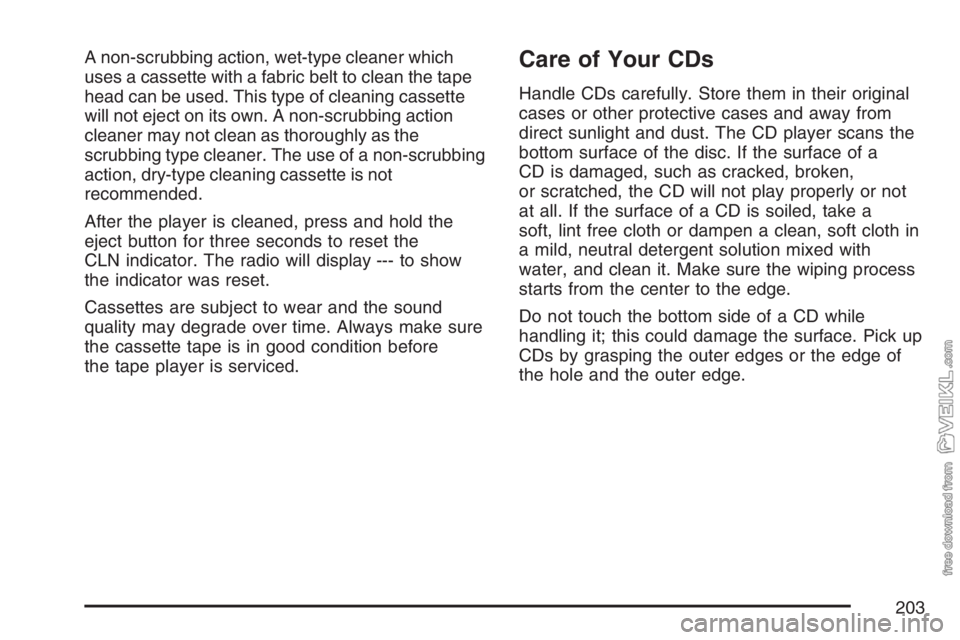
A non-scrubbing action, wet-type cleaner which
uses a cassette with a fabric belt to clean the tape
head can be used. This type of cleaning cassette
will not eject on its own. A non-scrubbing action
cleaner may not clean as thoroughly as the
scrubbing type cleaner. The use of a non-scrubbing
action, dry-type cleaning cassette is not
recommended.
After the player is cleaned, press and hold the
eject button for three seconds to reset the
CLN indicator. The radio will display --- to show
the indicator was reset.
Cassettes are subject to wear and the sound
quality may degrade over time. Always make sure
the cassette tape is in good condition before
the tape player is serviced.Care of Your CDs
Handle CDs carefully. Store them in their original
cases or other protective cases and away from
direct sunlight and dust. The CD player scans the
bottom surface of the disc. If the surface of a
CD is damaged, such as cracked, broken,
or scratched, the CD will not play properly or not
at all. If the surface of a CD is soiled, take a
soft, lint free cloth or dampen a clean, soft cloth in
a mild, neutral detergent solution mixed with
water, and clean it. Make sure the wiping process
starts from the center to the edge.
Do not touch the bottom side of a CD while
handling it; this could damage the surface. Pick up
CDs by grasping the outer edges or the edge of
the hole and the outer edge.
203
Page 253 of 430
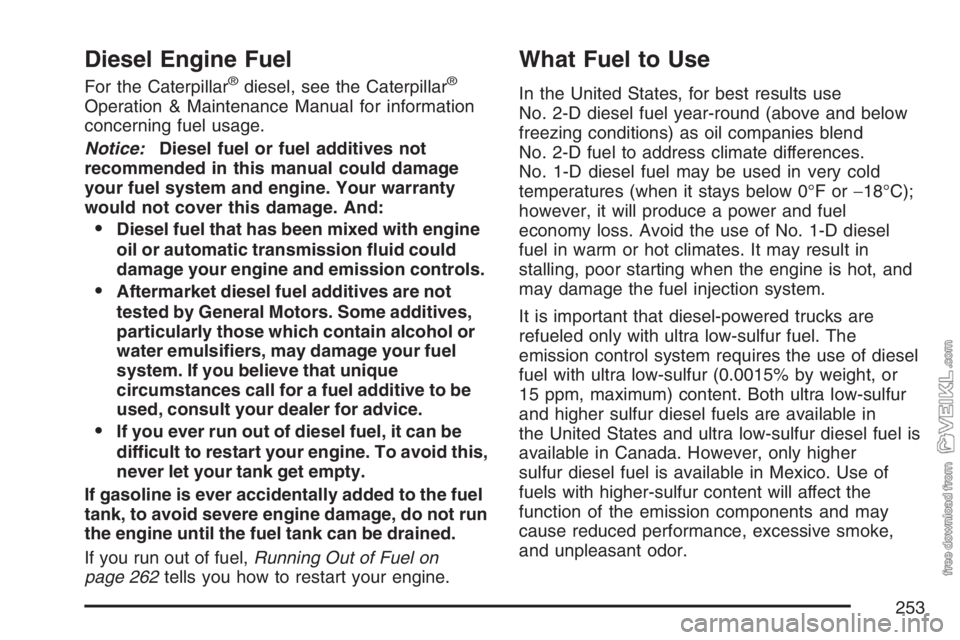
Diesel Engine Fuel
For the Caterpillar®diesel, see the Caterpillar®
Operation & Maintenance Manual for information
concerning fuel usage.
Notice:Diesel fuel or fuel additives not
recommended in this manual could damage
your fuel system and engine. Your warranty
would not cover this damage. And:
Diesel fuel that has been mixed with engine
oil or automatic transmission �uid could
damage your engine and emission controls.
Aftermarket diesel fuel additives are not
tested by General Motors. Some additives,
particularly those which contain alcohol or
water emulsi�ers, may damage your fuel
system. If you believe that unique
circumstances call for a fuel additive to be
used, consult your dealer for advice.
If you ever run out of diesel fuel, it can be
difficult to restart your engine. To avoid this,
never let your tank get empty.
If gasoline is ever accidentally added to the fuel
tank, to avoid severe engine damage, do not run
the engine until the fuel tank can be drained.
If you run out of fuel,Running Out of Fuel on
page 262tells you how to restart your engine.
What Fuel to Use
In the United States, for best results use
No. 2-D diesel fuel year-round (above and below
freezing conditions) as oil companies blend
No. 2-D fuel to address climate differences.
No. 1-D diesel fuel may be used in very cold
temperatures (when it stays below 0°F or−18°C);
however, it will produce a power and fuel
economy loss. Avoid the use of No. 1-D diesel
fuel in warm or hot climates. It may result in
stalling, poor starting when the engine is hot, and
may damage the fuel injection system.
It is important that diesel-powered trucks are
refueled only with ultra low-sulfur fuel. The
emission control system requires the use of diesel
fuel with ultra low-sulfur (0.0015% by weight, or
15 ppm, maximum) content. Both ultra low-sulfur
and higher sulfur diesel fuels are available in
the United States and ultra low-sulfur diesel fuel is
available in Canada. However, only higher
sulfur diesel fuel is available in Mexico. Use of
fuels with higher-sulfur content will affect the
function of the emission components and may
cause reduced performance, excessive smoke,
and unpleasant odor.
253
Page 254 of 430
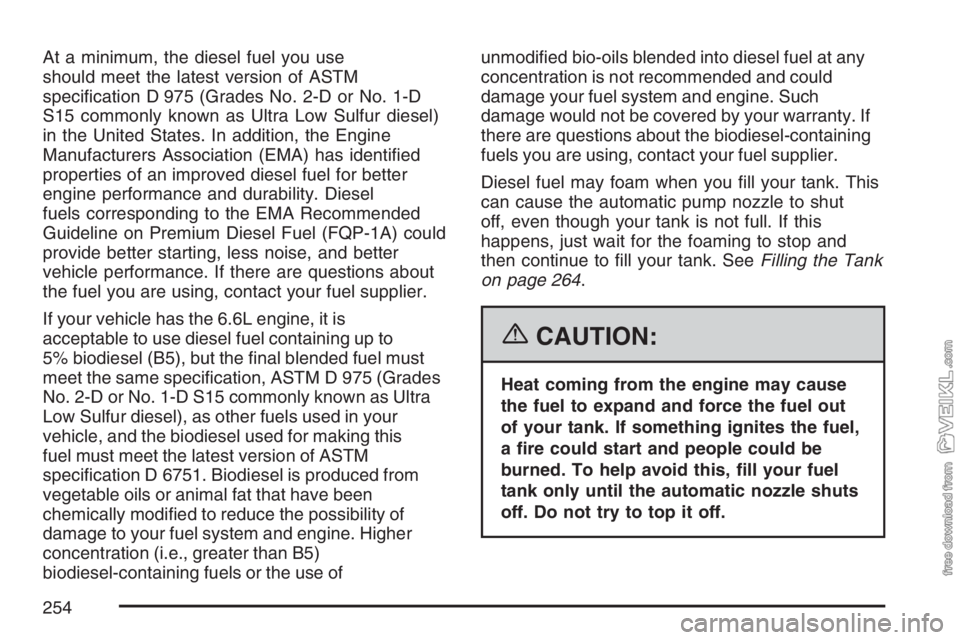
At a minimum, the diesel fuel you use
should meet the latest version of ASTM
specification D 975 (Grades No. 2-D or No. 1-D
S15 commonly known as Ultra Low Sulfur diesel)
in the United States. In addition, the Engine
Manufacturers Association (EMA) has identified
properties of an improved diesel fuel for better
engine performance and durability. Diesel
fuels corresponding to the EMA Recommended
Guideline on Premium Diesel Fuel (FQP-1A) could
provide better starting, less noise, and better
vehicle performance. If there are questions about
the fuel you are using, contact your fuel supplier.
If your vehicle has the 6.6L engine, it is
acceptable to use diesel fuel containing up to
5% biodiesel (B5), but the final blended fuel must
meet the same specification, ASTM D 975 (Grades
No. 2-D or No. 1-D S15 commonly known as Ultra
Low Sulfur diesel), as other fuels used in your
vehicle, and the biodiesel used for making this
fuel must meet the latest version of ASTM
specification D 6751. Biodiesel is produced from
vegetable oils or animal fat that have been
chemically modified to reduce the possibility of
damage to your fuel system and engine. Higher
concentration (i.e., greater than B5)
biodiesel-containing fuels or the use ofunmodified bio-oils blended into diesel fuel at any
concentration is not recommended and could
damage your fuel system and engine. Such
damage would not be covered by your warranty. If
there are questions about the biodiesel-containing
fuels you are using, contact your fuel supplier.
Diesel fuel may foam when you fill your tank. This
can cause the automatic pump nozzle to shut
off, even though your tank is not full. If this
happens, just wait for the foaming to stop and
then continue to fill your tank. SeeFilling the Tank
on page 264.
{CAUTION:
Heat coming from the engine may cause
the fuel to expand and force the fuel out
of your tank. If something ignites the fuel,
a �re could start and people could be
burned. To help avoid this, �ll your fuel
tank only until the automatic nozzle shuts
off. Do not try to top it off.
254
Page 255 of 430
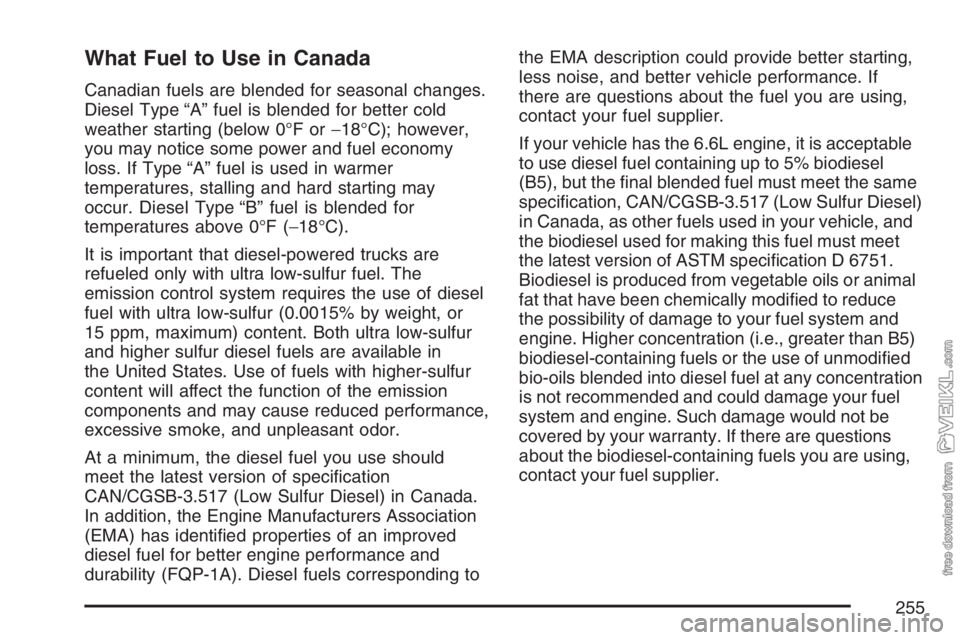
What Fuel to Use in Canada
Canadian fuels are blended for seasonal changes.
Diesel Type “A” fuel is blended for better cold
weather starting (below 0°F or−18°C); however,
you may notice some power and fuel economy
loss. If Type “A” fuel is used in warmer
temperatures, stalling and hard starting may
occur. Diesel Type “B” fuel is blended for
temperatures above 0°F (−18°C).
It is important that diesel-powered trucks are
refueled only with ultra low-sulfur fuel. The
emission control system requires the use of diesel
fuel with ultra low-sulfur (0.0015% by weight, or
15 ppm, maximum) content. Both ultra low-sulfur
and higher sulfur diesel fuels are available in
the United States. Use of fuels with higher-sulfur
content will affect the function of the emission
components and may cause reduced performance,
excessive smoke, and unpleasant odor.
At a minimum, the diesel fuel you use should
meet the latest version of specification
CAN/CGSB-3.517 (Low Sulfur Diesel) in Canada.
In addition, the Engine Manufacturers Association
(EMA) has identified properties of an improved
diesel fuel for better engine performance and
durability (FQP-1A). Diesel fuels corresponding tothe EMA description could provide better starting,
less noise, and better vehicle performance. If
there are questions about the fuel you are using,
contact your fuel supplier.
If your vehicle has the 6.6L engine, it is acceptable
to use diesel fuel containing up to 5% biodiesel
(B5), but the final blended fuel must meet the same
specification, CAN/CGSB-3.517 (Low Sulfur Diesel)
in Canada, as other fuels used in your vehicle, and
the biodiesel used for making this fuel must meet
the latest version of ASTM specification D 6751.
Biodiesel is produced from vegetable oils or animal
fat that have been chemically modified to reduce
the possibility of damage to your fuel system and
engine. Higher concentration (i.e., greater than B5)
biodiesel-containing fuels or the use of unmodified
bio-oils blended into diesel fuel at any concentration
is not recommended and could damage your fuel
system and engine. Such damage would not be
covered by your warranty. If there are questions
about the biodiesel-containing fuels you are using,
contact your fuel supplier.
255
Page 264 of 430
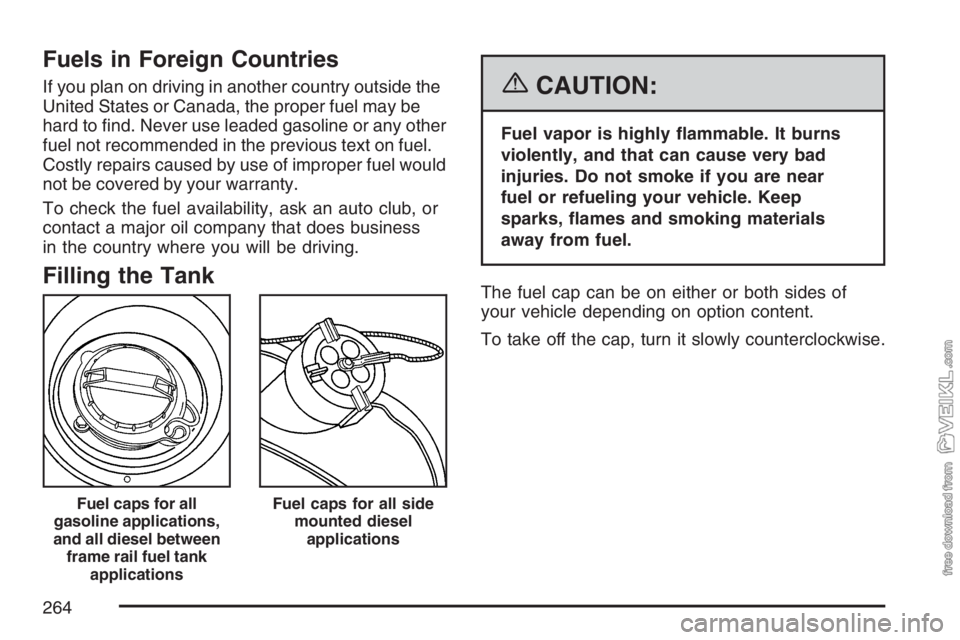
Fuels in Foreign Countries
If you plan on driving in another country outside the
United States or Canada, the proper fuel may be
hard to find. Never use leaded gasoline or any other
fuel not recommended in the previous text on fuel.
Costly repairs caused by use of improper fuel would
not be covered by your warranty.
To check the fuel availability, ask an auto club, or
contact a major oil company that does business
in the country where you will be driving.
Filling the Tank
{CAUTION:
Fuel vapor is highly �ammable. It burns
violently, and that can cause very bad
injuries. Do not smoke if you are near
fuel or refueling your vehicle. Keep
sparks, �ames and smoking materials
away from fuel.
The fuel cap can be on either or both sides of
your vehicle depending on option content.
To take off the cap, turn it slowly counterclockwise.
Fuel caps for all
gasoline applications,
and all diesel between
frame rail fuel tank
applicationsFuel caps for all side
mounted diesel
applications
264
Page 271 of 430
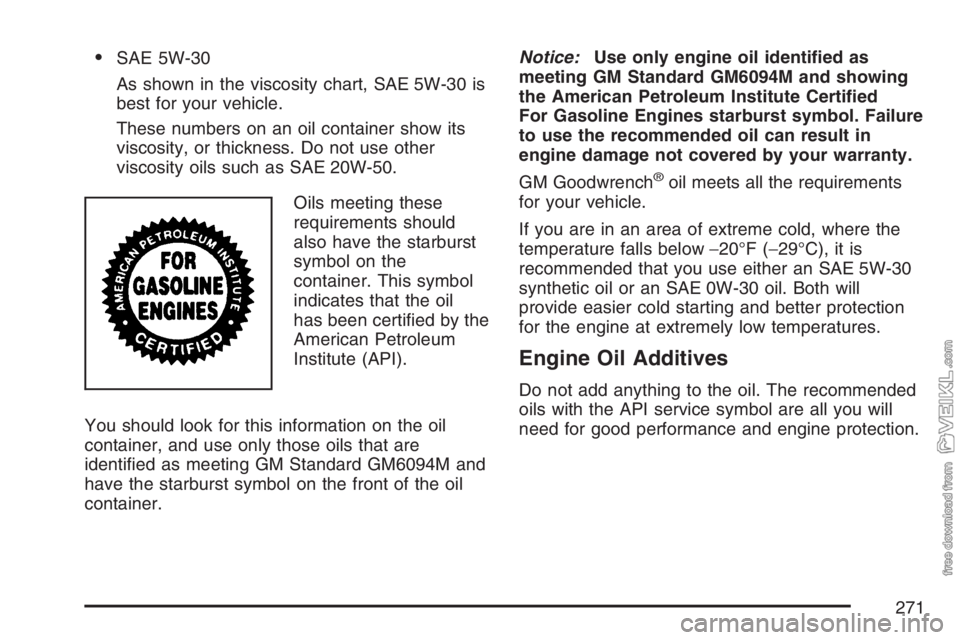
•SAE 5W-30
As shown in the viscosity chart, SAE 5W-30 is
best for your vehicle.
These numbers on an oil container show its
viscosity, or thickness. Do not use other
viscosity oils such as SAE 20W-50.
Oils meeting these
requirements should
also have the starburst
symbol on the
container. This symbol
indicates that the oil
has been certified by the
American Petroleum
Institute (API).
You should look for this information on the oil
container, and use only those oils that are
identified as meeting GM Standard GM6094M and
have the starburst symbol on the front of the oil
container.Notice:Use only engine oil identi�ed as
meeting GM Standard GM6094M and showing
the American Petroleum Institute Certi�ed
For Gasoline Engines starburst symbol. Failure
to use the recommended oil can result in
engine damage not covered by your warranty.
GM Goodwrench
®oil meets all the requirements
for your vehicle.
If you are in an area of extreme cold, where the
temperature falls below−20°F (−29°C), it is
recommended that you use either an SAE 5W-30
synthetic oil or an SAE 0W-30 oil. Both will
provide easier cold starting and better protection
for the engine at extremely low temperatures.
Engine Oil Additives
Do not add anything to the oil. The recommended
oils with the API service symbol are all you will
need for good performance and engine protection.
271
Page 274 of 430

Add oil at the engine oil
fill cap in the engine
compartment. Install and
fully tighten the fill
cap when you
are through.
Be sure to add enough oil to put the level
somewhere in the proper operating range. Push
the dipstick all the way back in when you are
through.What Kind of Engine Oil to Use
Look for these two things:
•CJ-4 or CI-4
Oils designated as API CJ-4 or CI-4 are
recommended for your vehicle. The CJ-4 or
CI-4 designations may appear either
alone, together, or in combination with other
API designations, such as API CJ-4/SM.
These letters show American Petroleum
Institute (API) levels of quality.
Notice:Use only engine oils that have one of
these designations, CJ-4 or CI-4, for the
diesel engine. Failure to use the recommended
oils can result in engine damage not covered
by your warranty.
274
Page 275 of 430
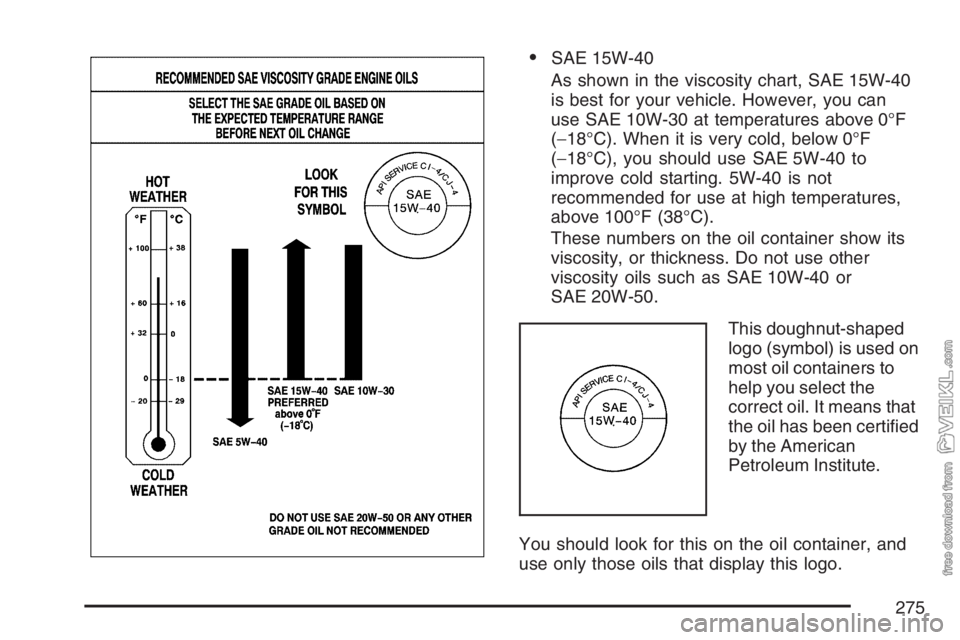
•SAE 15W-40
As shown in the viscosity chart, SAE 15W-40
is best for your vehicle. However, you can
use SAE 10W-30 at temperatures above 0°F
(−18°C). When it is very cold, below 0°F
(−18°C), you should use SAE 5W-40 to
improve cold starting. 5W-40 is not
recommended for use at high temperatures,
above 100°F (38°C).
These numbers on the oil container show its
viscosity, or thickness. Do not use other
viscosity oils such as SAE 10W-40 or
SAE 20W-50.
This doughnut-shaped
logo (symbol) is used on
most oil containers to
help you select the
correct oil. It means that
the oil has been certified
by the American
Petroleum Institute.
You should look for this on the oil container, and
use only those oils that display this logo.
275
Page 276 of 430
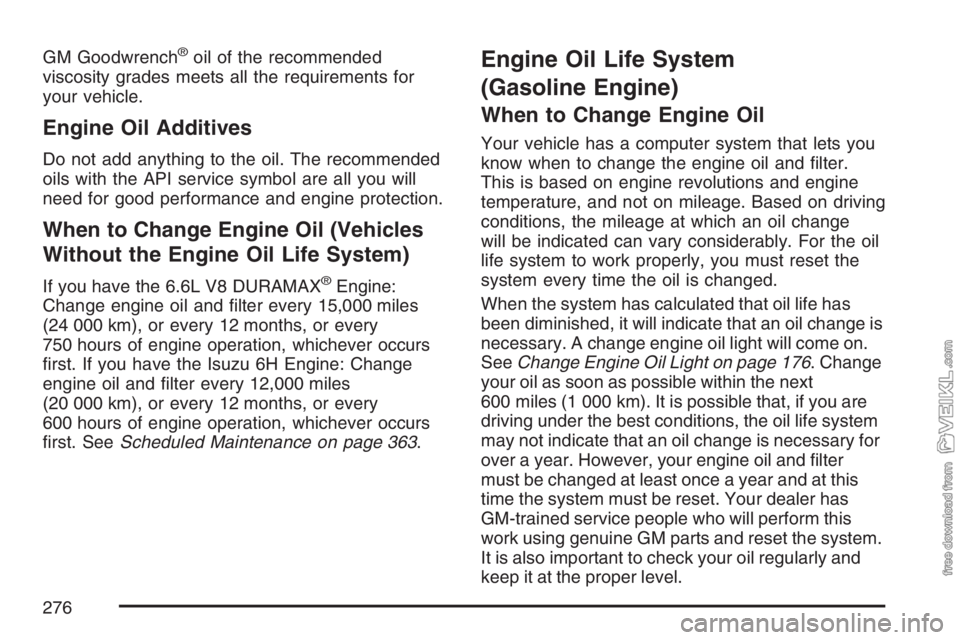
GM Goodwrench®oil of the recommended
viscosity grades meets all the requirements for
your vehicle.
Engine Oil Additives
Do not add anything to the oil. The recommended
oils with the API service symbol are all you will
need for good performance and engine protection.
When to Change Engine Oil (Vehicles
Without the Engine Oil Life System)
If you have the 6.6L V8 DURAMAX®Engine:
Change engine oil and filter every 15,000 miles
(24 000 km), or every 12 months, or every
750 hours of engine operation, whichever occurs
first. If you have the Isuzu 6H Engine: Change
engine oil and filter every 12,000 miles
(20 000 km), or every 12 months, or every
600 hours of engine operation, whichever occurs
first. SeeScheduled Maintenance on page 363.
Engine Oil Life System
(Gasoline Engine)
When to Change Engine Oil
Your vehicle has a computer system that lets you
know when to change the engine oil and filter.
This is based on engine revolutions and engine
temperature, and not on mileage. Based on driving
conditions, the mileage at which an oil change
will be indicated can vary considerably. For the oil
life system to work properly, you must reset the
system every time the oil is changed.
When the system has calculated that oil life has
been diminished, it will indicate that an oil change is
necessary. A change engine oil light will come on.
SeeChange Engine Oil Light on page 176. Change
your oil as soon as possible within the next
600 miles (1 000 km). It is possible that, if you are
driving under the best conditions, the oil life system
may not indicate that an oil change is necessary for
over a year. However, your engine oil and filter
must be changed at least once a year and at this
time the system must be reset. Your dealer has
GM-trained service people who will perform this
work using genuine GM parts and reset the system.
It is also important to check your oil regularly and
keep it at the proper level.
276